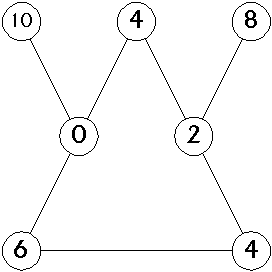
プログラムの出力結果は以下の通り。
Find A:10, B: 4, C: 8, D: 0, E: 2, F: 6, G: 4 Find A:10, B: 4, C: 8, D: 0, E: 2, F: 6, G: 4 Find A: 8, B: 4, C:10, D: 2, E: 0, F: 4, G: 6 Find A: 8, B: 4, C:10, D: 2, E: 0, F: 4, G: 6 cnt:5040
4件出力されているが上2件,下2件は同じ。
これはネズミが2匹いたため。上2件と下2件は左右が対称の結果なので,実質1件。
図示すると以下の通り。

プログラムは以下の通り。
#include "puzutl.h"
YesNo used[7];
int nleg[7] = { 10, 8, 6, 2, 0, 4, 4 }; // イカ,蛸(タコ),甲虫(カブトムシ),雀(スズメ),蛇(ヘビ),鼠(ネズミ),鼠(ネズミ)の足の数
int main( int argc, cstring argv[])
{
int cnt = 0;
for( int a=0; a< 7; a++) {
used[a] = YES;
for( int b=0; b< 7; b++) {
if( used[b]) continue;
used[b] = YES;
for( int c=0; c< 7; c++) {
if( used[c]) continue;
used[c] = YES;
for( int d=0; d< 7; d++) {
if( used[d]) continue;
used[d] = YES;
for( int e=0; e< 7; e++) {
if( used[e]) continue;
used[e] = YES;
for( int f=0; f< 7; f++) {
if( used[f]) continue;
used[f] = YES;
for( int g=0; g< 7; g++) {
if( used[g]) continue;
int n1 = nleg[a] + nleg[d];
int n2 = nleg[b] + nleg[d] + nleg[f] ;
int n3 = nleg[f] + nleg[g] ;
int n4 = nleg[b] + nleg[e] + nleg[g] ;
int n5 = nleg[c] + nleg[e] ;
if( n1 == n2 && n2 == n3 && n3 == n4 && n4 == n5) {
ps( "Find A:%2d, B:%2d, C:%2d, D:%2d, E:%2d, F:%2d, G:%2d\n", nleg[a], nleg[b], nleg[c], nleg[d], nleg[e], nleg[f], nleg[g]);
}
cnt++;
}
used[f] = NO;
}
used[e] = NO;
}
used[d] = NO;
}
used[c] = NO;
}
used[b] = NO;
}
used[a] = NO;
}
ps( "cnt:%d\n", cnt);
return 0;
}